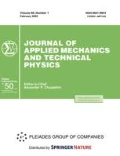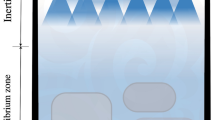Abstract
The aim of this study is to investigate the effect of diversity of particles in the downstream cloud on detonation wave suppression. The multi-component two-phase model for a reacting compressible flow field including clouds of chemically inert solid particles is utilized here. The detonation wave is simulated in a stoichiometric hydrogen and oxygen mixture using a detailed full chemistry model. The finite volume scheme is used in the developed numerical program, where the advection upstream splitting method is used in addition to the Saurel method for the multi-particle cloud in order to compute the particle-phase and gas-phase fluxes. The impact of the detonation wave on the rigid wall is investigated, and the magnitude of the resulting pressure rise is accurately predicted in the case of a head-on collision of two similar waves instead of direct simulation of the wall reflection. The results demonstrate that the impact pressure rise is rather strong and destructive, and using a multi-component particle cloud may have better attenuating features for both short and long action times and require a shorter required propagation length for detonation wave suppression than using a single-component particle cloud.
Similar content being viewed by others
References
J. Li, W. Fan, and H. Qiu, “Preliminary Study of a Pulse Normal Detonation Wave Engine,” Aerospace Sci. Technol. 14, 161–167 (2010).
T. P. Gavrilenko, V. V. Grigoriev, S. A. Zhdan, et al., “Acceleration of Solid Particles by Gaseous Detonation Products,” Combust. Flame 66, 121–128 (1986).
A. V. Fedorov and V. M. Fomin, “Detonation of the Gas Mixtures with Inert Solid Particles,” in IUTAM Symp. on Combustion in Supersonic Flows, Ed. by M. Champion, B. Deshaies (Springer, Dordrecht, 1997), pp. 187–191; https://doi.org/10.1007/978-94-011-5432-l_15.
R. O. Carvel, G. O. Thomas, and C. J. Brown, “Some Observations of Detonation Propagation through a Gas Containing Dust Particles in Suspension,” Shock Waves 13, 83–89 (2003).
P. Kosinsky, “Numerical Investigation of Explosion Suppression by Inert Particles in Straight Ducts,” J. Hazardous Mat. 154, 981–991 (2008).
P. A. Fomin and J. R. Chen, “Effect of Chemically Inert Particles on Parameters and Suppression of Detonation in Gases,” Combust. Explosion Shock Waves 45, 303–313 (2009).
K. C. Gottiparthi and S. Menon, “A Study of Interaction of Clouds of Inert Particles with Detonation in Gases,” Combust. Sci. Technol. 184, 406–433 (2012).
A. M. Tahsini, “Detonation Wave Attenuation in Dust-Free and Dusty Air,” J. Loss Prevent. Process Indust. 39, 24–29 (2016).
P. A. Fomin, A. V. Fedorov, and J. R. Chen, “Parameters for Attenuation and Suppression of Detonation Wave with Inert Particles,” Chem. Eng. Trans. 31, 847–852 (2013).
G. Stahl and J. Warnatz, “Numerical Investigation of Time-Dependent Properties and Extinction of Strained Methane- and Propane-Air Flamelets,” Combust. Flame 85, 285–299 (1991).
M. S. Liou, “A Sequel to AUSM: AUSM+,” J. Comput. Phys. 129, 364–382 (1996).
R. Saurel, E. Daniel, and J. C. Loraud, “Two-Phase Flows: Second-Order Schemes and Boundary Conditions,” AIAA J. 32, 1214–1221 (1994).
A. M. Tahsini and S. Tadayon Mousavi, “Investigating the Supersonic Combustion Efficiency for the Jet-in-Cross-Flow,” Int. J. Hydrogen Energy 40 (7), 3091–3097 (2015).
A. M. Tahsini, “Heat Release Effects on Drag Reduction in High Speed Flows,” Int. J. Heat Mass Transfer 57 (2), 657–661 (2013).
C. Morris, “Numerical Modeling of Single-Pulse Gasdynamics and Performance of Pulse Detonation Rocket Engines,” Propuls. Power. 21 (3), 527–538 (2005).
Author information
Authors and Affiliations
Corresponding author
Additional information
__________
Translated from Prikladnaya Mekhanika i Tekhnicheskaya Fizika, Vol. 61, No. 1, pp. 63–70, January–February, 2020.
Original Russian Text © A.M. Tahsini.
Rights and permissions
About this article
Cite this article
Tahsini, A.M. Suppression of the Detonation Wave with the Aid of a Multi-Component Particle Cloud. J Appl Mech Tech Phy 61, 54–60 (2020). https://doi.org/10.1134/S002189442001006X
Received:
Revised:
Accepted:
Published:
Issue Date:
DOI: https://doi.org/10.1134/S002189442001006X




